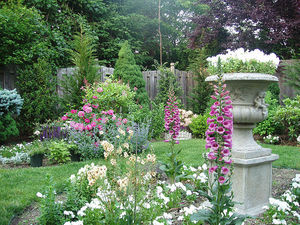By following a few basic techniques you can remove the lumps and bumps from lawn areas in order to create a more level finish.
Many areas of lawn develop an uneven surface that makes them difficult to mow and to maintain. Heavy rain can sometimes cause the soil to subside, making the surface levels variable.
Routine wear and tear, such as a lot of foot traffic, can also compact the lawn, creating dips and troughs in the surface. Then there are family pets, such as dogs that dig holes, thereby spoiling the effect of a smooth, green lawn.
Lawns that have been turfed or sown from seed can also be uneven if the site was not prepared properly beforehand. This is a problem that should be corrected once the lawn has become established.
These problem spots can make walking dangerous, and will detract from the finished look of your garden. After mowing, the lawn will still appear uneven and, after rainfall, water will collect in these areas, making them boggy.
The wheels of your lawnmower can become stuck in uneven patches or holes, causing the blades to cut into the soil itself. This creates ugly bare patches which are vulnerable to infestation by weeds.
Your approach to leveling the lawn will depend on the extent of the problem. For small dips, troughs and ridges, it is simply a matter of filling them in and then sowing more lawn seed to create a new and even surface.
When the entire lawn has developed an uneven surface, it may be preferable to lift the grass in strips and to create a new, level surface, which can be smoothed with a length of timber. It may even be necessary to install a small retaining wall to support the new level.
When the surface has been prepared, the lawn can be re-laid. This type of repair work should be done in autumn, giving the lawn time to become established before winter.
For minor leveling repairs you will need”
Light soil
Compost
Metal rake
Lawn seed
1. Use a good mixture of light soil and compost to fill any areas of the lawn that have holes, dips or ridges. Firm the soil down well.
2. Use a metal rake to smooth the filled in areas, allowing the soil to blend with the grass on either side. A timber plank with a straight edge can also be drawn across the grass to create a smooth level between the existing lawn and the area being repaired.
3. Sow the lawn seed over the entire area, allowing it to spread into surrounding areas. For dense germination, use more seed than is recommended.
4. Water well after sowing the seeds, and continue twice daily until germination. This can take up to fourteen days. In hot weather, cover the newly planted areas with shade cloth in the middle of the day.
Major leveling repairs
After you have lifted the grass, build a retaining wall of stone or timber to support the new level. You may need to import extra topsoil to fill behind the wall.
When the surface is smooth and level, relay the lawn in strips right up to the retaining wall, then water well until the lawn is established.
A few aftercare tips
Protect newly repaired areas of the lawn with a barrier that will prevent people or animals from walking across it. Small repairs can be protected with sections of bamboo stakes and string, while larger areas will need timber stakes and chicken wire to prevent foot traffic.
One the grass seeds have germinated, use a liquid organic fertilizer to boost healthy growth. Feeding at this stage will encourage a denser, even coverage as well as strong, healthy root production.
Avoid mowing the new grass until it has reached a height of at least 5-8cm. Mowing before this can tear the grass seedlings from the ground, and make the patched area appear thin and uneven.
Do not attempt lifting the lawn or working the soil after heavy rain. Soil that is waterlogged is difficult to handle, and too much disturbance can destroy the soil structure.
Seasonal tips
Summer: Watering and aerating
Compaction problems are at their worst at this time of year. Continue watering the lawn well through the summer months and use a fork to aerate the entire area to prevent further compaction.
Autumn: Leveling and sowing
This is the best time of year to level the lawn, as the seed prefers slightly cooler temperatures for germination. Keep the area well watered until the seeds start to sprout.
Spring: Watering and feeding
When the weather grows warmer, start a regime of regular watering, and fertilize the entire lawn with a specifically formulated lawn food. Mow the lawn weekly from mid-spring onwards.

